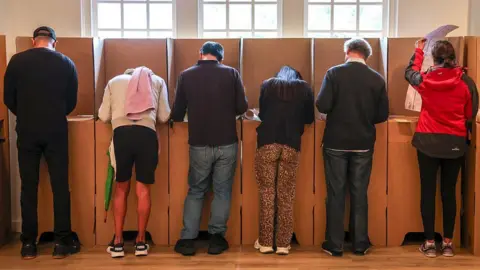Australia: A guide to election day
After weeks of campaigning, Australia's 2025 federal election is here - and its looking to be a tight race between the incumbent Anthony Albanese and opposition leader Peter Dutton.
If you're planning on staying up late to watch the results roll in tonight, here's a quick look at what you need to know.
Who are the main players?
The two main candidates for the prime minister's seat are the current premier Anthony Albanese and his opposition rival Peter Dutton.
Albanese, who heads the Labor party, enjoyed a period of broad popularity after coming to power but in recent years has come under pressure over his handling of divisive topics like housing, Indigenous affairs and both antisemitism and Islamophobia.
Dutton, who is head of the Liberal-National coalition, is known as a staunch conservative and has experience holding important ministerial portfolios, like defence and home affairs. However, he has been a controversial figure at times, particularly on social issues.
There are also the left-leaning Greens, Australia's third largest political party, as well as a wave of "Teal candidates" - independent candidates who have been running on a strong climate platform.
When do polls close?
Wherever you are in Australia, polls close at 18:00 - but the country's three different time zones means there isn't one standard time where all polls shut.
The eastern states of Australia - New South Wales, Victoria and Queensland which follow Australian Eastern Standard Time - will be among the first places to close at 18:00 local time, or 08:00 GMT.
Next will come South Australia, as well as the Northern Territory and the Australian Capital Territory, followed by the state of Western Australia.
The last polling booths - in the ting, far-flung Australian territory of the Cocos (Keeling) Islands - will close 12.30 GMT.
 Getty Images
Getty ImagesWhat about exit polls?
Unlike most countries including the US and UK, exit polls aren't big in Australia, mostly because early voting - which opens two weeks before the election - is common, and because polling stations across the country close at different times.
But counting in each state begins straight after polls close. Results are updated in real time on the Australian Electoral Commission (AEC) website - in what is known as an unofficial preliminary count, with Australians typically getting an unofficial result the same night.
The AEC also provides what's known as an "indicative count", which media commentators, election experts and sometimes even the parties and candidates themselves then base their calls on.
This sees counting officers conduct what is called a two-candidate-preferred count between the two leading candidates in each electoral district. This gives citizens a quick indication of who could form the government.
Australian pollsters also have a good track record of picking political winners, with a 96% success rate between 2007 and 2016, according to a report by the Australian Broadcasting Corporation (ABC). The exception was in 2019, when polls showed Labor to be ahead - but the election was won by then Coalition prime minister Scott Morrison.
When will we know who has won?
It is usually days or weeks before an official result is released by the AEC as they have to go through a rigorous counting process, tallying approximately 18 million ballot papers by hand, including postal and overseas ballot papers.
But citizens usually look to media outlets and election experts - like Australia's national broadcaster ABC - to call the unofficial results on election night.
In the last election in 2022, the ABC announced the results at 21:30 - just three and a half hours after polls closed on the east coast.
And as the night goes on, parties also come out to declare their win - or loss - so it might play out in the form of a victory speech, or in one conceding defeat.
There is no one specific time when the results are called, but 2022 gives a sense of how quickly we might be able see a winner. However if it proves to be a tight race, this process could take quite a while longer.
In the case of a hung parliament, it might take days or weeks before a result is called. In 2010, which is the last time Australia had a hung parliament, it took 17 days of post-election negotiations for a government to be formed - with both the Labor Party and the Coalition vying to win the support of six crossbenchers. In the end, Labor was able to form a minority government.
So depending on the scenario that plays out, Australians might have to hang on to their edge of their seats for a while longer before an official result emerges.
